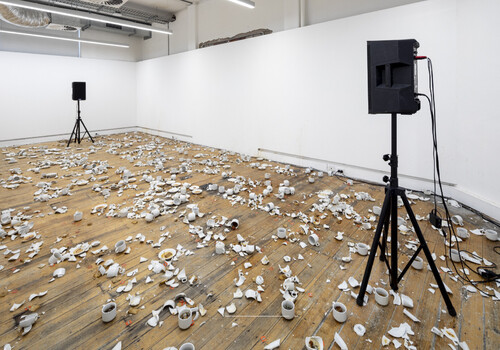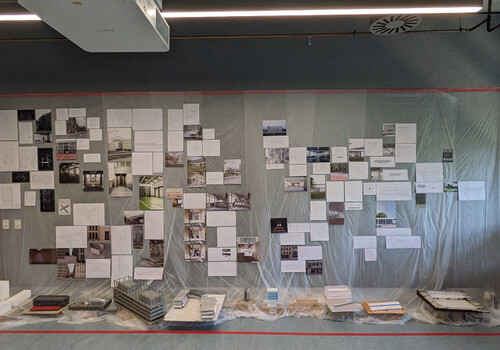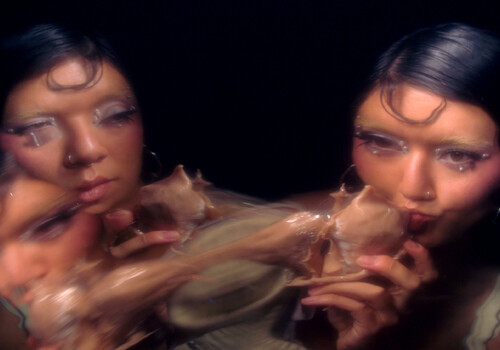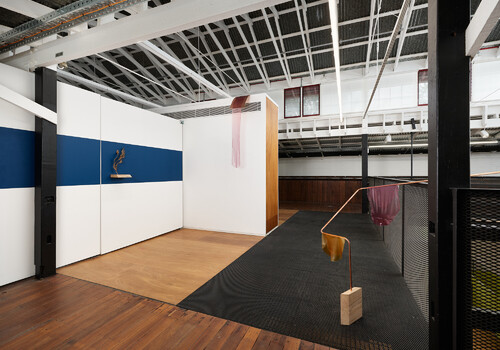Bachelor of Fine Art (Honours), UNSW Art & Design
By Claudia Blane
“Fuck it’s hard to get here,” I think to myself as the glass doors to UNSW’s The Annual swing open. The truck exhaust choking Oxford Street has made my forearms greyish with some sort of silty film, so I’m relieved when I hear water running on the other side of the building. As I edge past name tags, thickly-framed glasses, and graduate paintings sodden with spray-painted, screen-printed significance, my open Notes app burns a hole through my pocket.

Installation view of Zi Qin, Late Night Again, 2024, various materials, UNSW Galleries, Sydney.
Zi Qin’s Late Night Again (2024) isn’t exactly the faulty tap and basin I was picturing. A single shower cubicle plugged into the deepest, dimmest corner of the gallery, it carves an oasis out of the opening’s frenzy. Inside its cubic metre, there’s solitude. Grout blanched with peroxide. Standing room for one. Two if you squeeze. Water spurts from a moon-like shower head, veins the plastic screen, hastily dribbles downward. This particular booth is empty, of course—no hazy figure behind the condensation sponging their armpits with bar soap, or leaning a head back to rinse off shampoo—but I avert my gaze when I realise I’ve been staring.
On the wall-facing side of the cubicle stands the other half of Qin’s installation. It’s a desolate traffic light, the fiery blaze of its three indicators mottled by a coarse strip of plastic. I guess their illumination means I have permission to go, or slow, or stop, but that’s just the thing: though adrift in this hollow space, I don’t feel shepherded toward any particular action or conclusion. Half-dissolved memories float to the surface in their absence. I’m not sure whether they’re mine or Qin’s. Deserted freeway. GO. Timid footfall down the stairs. SLOW. Rivulets of warm water, faint gurgling down the drain. STOP.
There are lots of things that can make you feel dirty at an opening, like scabbed cigarette smoke or networking. By placing its viewers on the threshold of a wet, steaming shower, Qin’s installation invokes a brief reprieve from the conversation, the street smog, the heat and press of strangers’ bodies.

Installation view of Abigail Montgomery, Buffer Zone, 2024, immersive media installation, UNSW Galleries, Sydney. Photo: Cassandra Hannagan.
I turn to see a woman wearing ballerina flats crouched and fiddling with a knob on Abigail Montgomery’s Buffer Zone (2024).
“Mm mm mm,” she hums.
A wreckage of decommissioned detritus crowds her in: one vintage submarine radio, one steel gramophone, two beige telephones, four wooden plinths slicked with sexy maraschino gloss. Without warning, the gramophone spits out some alien garble. We look at each other questioningly.
“Was that you?”
“I don’t know, actually.”
Another subterranean wail. A pencil fixed to a makeshift seismograph scuds enthusiastically over thin air, recording nothing. The stranger offers me a pressed smile, lifting her shoulders slightly, and shuffles back into the previous room. The gramophone doesn’t protest.

Lucy McLauchlan, The Unconscious Mind, 2024, charcoal powder and acrylic paint on canvas with documentation of the process, UNSW Galleries, Sydney.
2024’s The Annual was complex and provocative, but I found myself searching for a lull in the chatter in the same way that I look for an empty room at a party. Qin and Montgomery’s installations, mired deep in its guts, embrace fatigue by relieving us of the reflex to constantly decode and decipher the new works we’re encountering. The result is a submersion that is both intimate and impersonal; involuntary, yet instinctual.
Back on Oxford Street, Lucy McLauchlan’s The Unconscious Mind (2024)—two stretched, bedsheet-like canvases flecked with gestural smudges of charcoal and black acrylic paint—seems like a pretty apt illustration of the way my brain feels: clean, but noticeably stained. In an exhibition housing 187 students’ works, the residue that sticks is that which stands out: that spits, scrubs, washes away.
Claudia is an English student at the University of Sydney, writing and creating on Gadigal land.









































